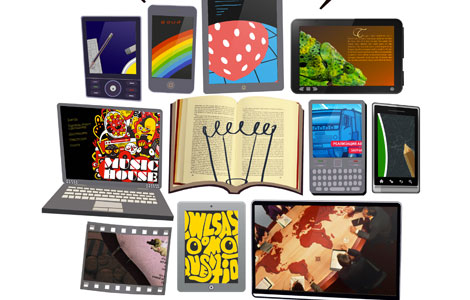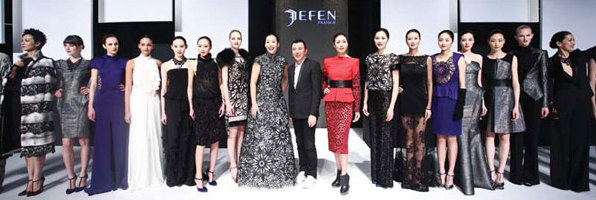Brand builder returns in triumph from French fashion scene
Updated: 2013-07-15 07:24
By Yao Jing (China Daily)
|
|||||||||||
|
Xie Feng says his designs have a strong European influence, but that they also contain Chinese elements. Provided to China Daily |
Designer realized a dream but now concentrates on China's market
For Chinese fashion designer Xie Feng the idea of his clothes appearing at a Paris fashion show was a "dream". But seven years ago the founder of Jefen not only realized that dream, but he also became a pioneer as the first Chinese designer to show at the French capital's famous fashion week.
Now he is pushing his clothes among China's fashion-conscious crowd and sees a growing audience for Chinese design worldwide.
Although Jefen was registered in Italy in 1998, the 2006 Paris Fashion Week was the first time Xie took his brand to the European market.
It was a defining moment for the Chinese fashionista, who had long imagined his designs being strutted along a Parisian catwalk.
"Before going there I had regarded it as a personal dream. But standing there, watching people look at my clothes, I realized it was a sign that it is time for Chinese brands and designers," he says.
Xie, who formerly worked for Japanese fashion house Nicole Company for almost 10 years, has shown his designs eight times at Paris Fashion Week and also expanded his business with a strong focus on the emerging Chinese market.
China was in fact Xie's original market for the Jefen brand. Despite registering in Europe, its first sales were in China, where it targeted "independent women" between 30 and 40, with Italian wool, silk and linen fabrics that were "comfortable and noble".
Xie promoted Jefen then, and still does, as a high-end Chinese brand, in part because he did not want it to become confused with Italian brand fakes, which litter China's clothing markets.
It was initially a tough sell, but Xie has managed to establish a market for Jefen and expand the company from three staff to more than 600, with turnover in excess of 400 million yuan ($65 million) last year.
"We are growing on average 30 to 40 percent a year, except for 2012 when turnover increased by just 20 percent because of a slowdown in the economy," says Xie.
This year marks another turning point for the company, which released its latest clothing collection, Samsara, at Beijing Fashion Week in April. Xie says it is undergoing a "rebirth" to become a larger brand.
"We are figuring out how to make the jump," he says. "As I am employing more people I feel I have a responsibility to expand the business to offer them a better life. I hope to have a quality design team working for the company instead of just myself."
These are ambitious plans for Jefen, whose business life began in a 20-square-meter shop on the fifth floor of Scitech Plaza, one of Beijing's first high-end shopping malls. The company now has 80 shops across China.
In the early days it was difficult for the shop to attract customers. "We were placed among children's brands and out-of-season clothing sales areas in the shopping mall in 2000 and few people knew much about designer brands at that time," Xie says.
"People were more conservative and couldn't accept fashionable designs. Some said that my pants were too tight and others said the suit collars were too low."
However, with the rapid emergence of a wealthy class in China's cities and a growing awareness of international brands, Jefen began to develop a following and in 2006 turned a corner.
"In 2006, the number of Jefen stores increased to 18 and income reached 60 million yuan," Xie says.
Meanwhile, Scitech Plaza offered the company larger space on the building's third floor.
With the business growing, Xie decided to realize his Parisian dream.
In the same year he also launched Jefen by Frankie, an offshoot higher-end brand, in France, priced at 20 to 30 percent more than other Jefen clothes. It focuses on formal evening dress using futuristic designs.
"Jefen by Frankie was sold in France through shows and showrooms, and most of the buyers came from the US and Japan. However, when the economic crisis arrived in 2008, sales volumes of the brand were also hit," Xie says.
He chose to bring the Jefen by Frankie brand back to China in 2008 to be sold alongside the original brand in his network of stores across the country.
Xie has also scaled back his Paris shows to concentrate on the Chinese market.
"As my market is mainly in China now, it is not appropriate to invest much time and money in shows in Paris," he says.
However, his connections to France remain and not just in the fashion scene.
In October 2011, he cooperated with Cafe de la Paix of Paris to design a dessert named Mixture of Chinese Fragrance and a French Sweet.
And this year and last year, his designs were in fashion shows at the Paris Le Grand hotel.
While his designs have a strong European influence and use mainly Italian fabrics, they also contain Chinese elements, among them Miao embroidery techniques.
"I spent a long time in Yunnan province learning embroidery methods there and the delicate and intricate patterns. I hope to do something for Miao embroidery and help local people get some orders to improve their lives," he says.
In his spare time, Xie plays golf and travels a lot to keep fit and open-minded.
yaojing@chinadaily.com.cn
(China Daily 07/15/2013 page13)
Today's Top News
Going private in healthcare 'is the future'
Snowden says he won't release harmful US data
More foreign companies involved in IPR cases
Local govts face financing woes
HK to lift controls on baby formula
Zimmerman not guilty
Largest vessel visits Indonesia
Urumqi residents hand in weapons
Hot Topics
Lunar probe , China growth forecasts, Emission rules get tougher, China seen through 'colored lens', International board,
Editor's Picks

|

|

|

|

|

|






